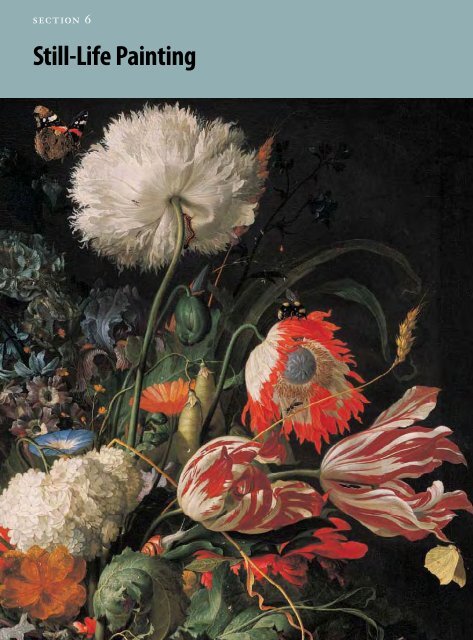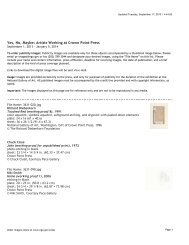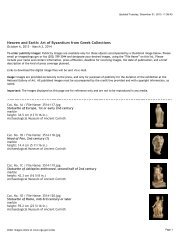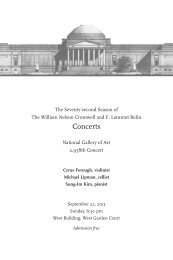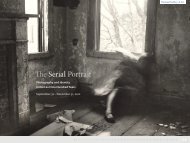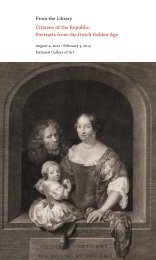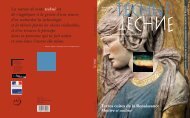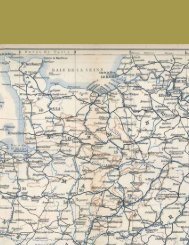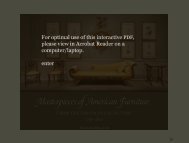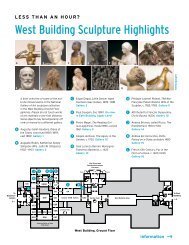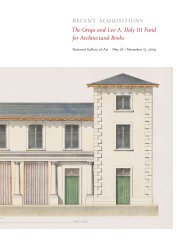SECTION 6 Still-Life Painting - National Gallery of Art
SECTION 6 Still-Life Painting - National Gallery of Art
SECTION 6 Still-Life Painting - National Gallery of Art
You also want an ePaper? Increase the reach of your titles
YUMPU automatically turns print PDFs into web optimized ePapers that Google loves.
<strong>SECTION</strong> 6<br />
<strong>Still</strong>-<strong>Life</strong> <strong>Painting</strong>
<strong>Still</strong>-life painting, as a subject worthy in its own right,<br />
seems to have appeared more or less simultaneously<br />
in Italy, northern Europe, and Spain in the sixteenth<br />
century. Painters turned their focus on plants, ani-<br />
mals, and man-made objects just as scientists and<br />
natural philosophers developed a new paradigm for<br />
learning about the world that emphasized investi-<br />
gation over abstract theory. Exploration, by Spain<br />
and the Netherlands especially, increased interest<br />
in exotic specimens from around the globe and<br />
created a market for their accurate renderings.<br />
<strong>Still</strong>-life painting also spoke more universally about<br />
the bounty <strong>of</strong> God’s creation and the nature <strong>of</strong> art<br />
and life. “Simple” paintings <strong>of</strong> flowers and food<br />
could have complex appeal and various meanings<br />
for viewers.<br />
Ars longa, vita brevis (<strong>Art</strong> is long, life is short)<br />
Painted images prolonged the experience <strong>of</strong> nature.<br />
Finely painted flowers brought tremendous pleasure<br />
during a cold Dutch winter. Permanence was consid-<br />
ered a great virtue <strong>of</strong> art—it outlasts nature. <strong>Still</strong> life<br />
reminded viewers <strong>of</strong> the prosperity <strong>of</strong> their repub-<br />
lic. It is probably not a coincidence that it emerged<br />
parallel with the world’s first consumer society. The<br />
Dutch were proud <strong>of</strong> their wealth and the effort that<br />
produced it, yet abundance could also nudge the<br />
conscience to contemplation <strong>of</strong> more weighty mat-<br />
ters. <strong>Painting</strong>s in which fruit rots, flowers wither,<br />
insects nibble at leaves, and expensively set tables lie<br />
asunder served as a memento mori or “reminder <strong>of</strong><br />
death,” intended to underscore life’s transience and<br />
the greater weight <strong>of</strong> moral considerations.<br />
<strong>Still</strong> life did not rank high with art theorists.<br />
Hoogstraten (see p. 125) called still-life painters<br />
“foot soldiers in the army <strong>of</strong> art.” Yet Dutch still-life<br />
paintings were hugely popular. They attracted some<br />
<strong>of</strong> the finest artists and commanded high prices.<br />
Many painters specialized in certain types <strong>of</strong> still<br />
life, including pictures <strong>of</strong> flowers or game, banquet<br />
and breakfast pieces that depict tables set with food,<br />
and vanitas still lifes, which reminded viewers <strong>of</strong> the<br />
emptiness <strong>of</strong> material pursuits.<br />
87
88<br />
Pieter Claesz, Dutch,<br />
1596/1597–1660,<br />
Breakfast Piece with<br />
Stoneware Jug, Wine Glass,<br />
Herring, and Bread, 1642,<br />
oil on panel, 6084<br />
(235⁄833), Museum<br />
<strong>of</strong> Fine <strong>Art</strong>s, Boston,<br />
Bequest <strong>of</strong> Mrs. Edward<br />
Wheelwright, 13.458<br />
Willem Kalf, Dutch, 1619–<br />
1693, <strong>Still</strong> <strong>Life</strong>, c. 1660, oil<br />
on canvas, 64.453.8<br />
(253⁄8213⁄16), <strong>National</strong><br />
<strong>Gallery</strong> <strong>of</strong> <strong>Art</strong>, Washington,<br />
Chester Dale Collection
STILL-LIFE SUBJECTS<br />
Breakfast and Banquet Pictures<br />
Pieter Claesz’ quiet tabletop still lifes, such as<br />
this simple breakfast <strong>of</strong> fish, bread, and beer, have<br />
extraordinary naturalism and directness. His warm,<br />
muted colors echo the tonal qualities that appeared<br />
in Haarlem landscapes around the same time (see<br />
p. 74). Willem Kalf’s more sumptuous painting<br />
reflects a later style, called pronkstileven, which<br />
featured brighter colors and more opulent objects,<br />
like this Chinese porcelain.<br />
Game Pictures<br />
Game pictures were especially sought by aristocratic<br />
patrons (or those with aristocratic pretensions) who<br />
alone had the land and means to practice the hunt.<br />
In this large painting Jan Weenix combined a still<br />
life—the textures <strong>of</strong> feathers and fur done with<br />
remarkable skill—with a landscape. The sculpted<br />
relief, pond, architectural follies, and garden statu-<br />
ary would have been found on a patrician estate. The<br />
painting, however, also has religious connotations:<br />
the relief represents the Holy Family, and the depart-<br />
ing dove beyond the dead swan probably relates to<br />
the freeing <strong>of</strong> the soul after death. Even the plants<br />
reinforce the symbolism—bending before the plinth<br />
is a calendula, symbolically associated with death,<br />
while the rose thorns in front recall Mary’s sorrows.<br />
Vanitas<br />
Like the Flemish painter Jan van Kessel, some Dutch<br />
painters also referred explicitly to the transience <strong>of</strong><br />
life by incorporating skulls, hourglasses, watches,<br />
and bubbles. All these reminders <strong>of</strong> death serve to<br />
underscore the “vanity” <strong>of</strong> life and the need to be<br />
morally prepared for final judgment.<br />
89<br />
Jan Weenix, Dutch,<br />
1642–1719, <strong>Still</strong> <strong>Life</strong> with<br />
Swan and Game before a<br />
Country Estate, c. 1685,<br />
oil on canvas, 142.9<br />
173 (56¼681⁄8),<br />
<strong>National</strong> <strong>Gallery</strong> <strong>of</strong> <strong>Art</strong>,<br />
Washington, Patrons’<br />
Permanent Fund<br />
Jan van Kessel, Flemish,<br />
1626–1679, Vanitas <strong>Still</strong><br />
<strong>Life</strong>, c. 1665/1670, oil on<br />
copper, 20.315.2 (8<br />
6), <strong>National</strong> <strong>Gallery</strong> <strong>of</strong> <strong>Art</strong>,<br />
Washington, Gift <strong>of</strong> Maida<br />
and George Abrams
In Focus Luxury and Lessons<br />
Flavored with currants and expen-<br />
sive spices, mince pie was a treat<br />
reserved for special occasions.<br />
Other foods on this sumptuously<br />
set table are also exceptional—im-<br />
ported lemons and olives, oysters<br />
to be enjoyed with vinegar from<br />
a Venetian glass cruet, seasonings<br />
<strong>of</strong> salt mounded in a silver cel-<br />
lar, and pepper sprinkled from a<br />
rolled paper cone. At the top <strong>of</strong><br />
Heda’s triangular arrangement is<br />
a splendid gilt bronze goblet. But<br />
the meal is over and the table in<br />
disarray. Two platters rest pre-<br />
cariously at the edge <strong>of</strong> the table.<br />
Vessels have fallen over and a glass<br />
has been broken. A candle has<br />
been snuffed out. Along with the<br />
edible items, these objects were<br />
familiar symbols <strong>of</strong> life’s imper-<br />
manence, reminders <strong>of</strong> the need<br />
90<br />
to be prepared for death and judg-<br />
ment. Another warning may lie<br />
in the oysters, which were com-<br />
monly regarded as aphrodisiacs.<br />
Empty shells litter the table, while<br />
in the center <strong>of</strong> the composition a<br />
simple roll remains the only food<br />
uneaten. Enjoying the pleasures<br />
<strong>of</strong> the flesh, these banqueters have<br />
ignored their salvation, leaving<br />
untouched the bread <strong>of</strong> life.<br />
Characterized by a contem-<br />
porary Haarlem historian as a<br />
painter <strong>of</strong> “fruit and all kinds <strong>of</strong><br />
knick-knacks,” Willem Claesz<br />
Heda was one <strong>of</strong> the greatest<br />
Dutch still-life artists, noted particularly<br />
for breakfast and banquet<br />
(ontbijtje and banketje) pieces. The<br />
large size <strong>of</strong> this painting suggests<br />
that it was probably made on<br />
commission. Its scale helps create<br />
the illusion <strong>of</strong> reality—objects are<br />
life-size. The projection <strong>of</strong> the<br />
two platters and knife handle and<br />
the dangling lemon peel bring the<br />
scene into the viewer’s own space.<br />
These elements, which increase<br />
the immediacy <strong>of</strong> seeing, connect<br />
viewers with Heda’s message<br />
about the true value in life.<br />
This painting is an example<br />
<strong>of</strong> the monochrome palette Dutch<br />
artists preferred for still lifes and<br />
landscapes (see p. 74) from the<br />
1620s to the late 1640s. Heda was<br />
a master <strong>of</strong> these cool gray or<br />
warm tan color schemes. The colors<br />
<strong>of</strong> gold, silver, pewter —even<br />
the vinegar and beer in their glass<br />
containers—play against a neutral<br />
background and white cloth.
91<br />
Willem Claesz Heda,<br />
Dutch, 1593/1594–1680,<br />
Banquet Piece with Mince<br />
Pie, 1635, oil on canvas,<br />
106.7111.1 (4243¾),<br />
<strong>National</strong> <strong>Gallery</strong> <strong>of</strong> <strong>Art</strong>,<br />
Washington, Patrons’<br />
Permanent Fund
FLOWERS AND FLOWER PAINTING<br />
The Dutch prized flowers and<br />
flower paintings; by the early<br />
seventeenth century, both were<br />
a national passion. Flowers were<br />
appreciated for beauty and fragrance<br />
and not simply for their<br />
value as medicine, herbs, or dyestuffs.<br />
Exotic new species from<br />
around the globe were avidly<br />
sought by botanists and gardeners.<br />
<strong>Painting</strong>s immortalized these<br />
treasures and made them available<br />
to study—and they gave sunny<br />
pleasure even in winter. Viewers<br />
could see—almost touch and<br />
smell—the blossoms.<br />
The Tulip Craze<br />
The Dutch were entranced most<br />
<strong>of</strong> all by flowering bulbs, especially<br />
tulips. After arriving in<br />
the Netherlands, probably in the<br />
1570s, tulips remained a luxurious<br />
rarity until the mid-1630s, when<br />
cheaper varieties turned the urban<br />
middle classes into avid collectors.<br />
The Dutch interest in tulips was<br />
also popularized around Europe,<br />
as visitors to the Netherlands<br />
were taken with these exotic<br />
flowers and with Dutch gardening<br />
prowess in general. At the<br />
same time, a futures market was<br />
established. Buyers contracted to<br />
purchase as-yet-ungrown bulbs<br />
at a set price, allowing bulbs to<br />
be traded at any time <strong>of</strong> the year.<br />
92<br />
On paper, the same bulb could<br />
quickly change hands many times<br />
over. Speculation drove prices<br />
upward. The price <strong>of</strong> a Semper<br />
Augustus was 1,000 guilders in<br />
1623, twice that in 1625, and up to<br />
5,000 guilders in 1637. The average<br />
price <strong>of</strong> a bulb that year was<br />
800 guilders, twice what a master<br />
carpenter made annually. A single<br />
tulip bulb could command as<br />
much as a fine house with a garden.<br />
People from all walks <strong>of</strong> life<br />
entered this speculative market,<br />
and many made “paper” fortunes,<br />
which disappeared after a glut<br />
caused prices to plummet.<br />
Among those ruined was the<br />
landscape painter Jan van Goyen<br />
(see section 10). Eventually bulb<br />
prices normalized to about 10<br />
percent <strong>of</strong> their peak value. They<br />
were still costly, but not outrageously<br />
so.<br />
This painting, based on a print, was made<br />
shortly after the tulip market’s collapse.<br />
Haarlem weavers, who have abandoned<br />
their looms, follow the goddess Flora as her<br />
chariot drives blindly to the sea. She holds<br />
out flamed red-and-white Semper Augustus<br />
tulips while another woman weighs bulbs,<br />
and other companions in fool’s caps, one<br />
with a bag <strong>of</strong> money, drink and chatter on.<br />
Hendrik Gerritsz Pot, Dutch, c. 1585–1657, Flora’s Wagon<br />
<strong>of</strong> Fools, c. 1637, oil on panel, 6183 (24325⁄8), Frans<br />
Hals Museum, Haarlem<br />
This watercolor was made for one <strong>of</strong><br />
the many tulpenboeken — illustrated<br />
catalogues <strong>of</strong> tulip varieties. Flamed<br />
tulips were highly sought after. Today it is<br />
understood that their broken color results<br />
from a virus.<br />
Unknown artist, Dutch, Geel en Roodt van Leydden (Yellow<br />
and Red <strong>of</strong> Leiden), from a tulip book, 1643, watercolor on<br />
parchment, volume 39.728.5 (155⁄811½), Frans Hals<br />
Museum, Haarlem
For religious reasons, Bosschaert moved from Antwerp to<br />
Middelburg, one <strong>of</strong> the centers <strong>of</strong> the Dutch East India Company and<br />
noted for its botanical garden. Several <strong>of</strong> the blooms he included<br />
here appear in more than one <strong>of</strong> his paintings, sometimes reversed.<br />
They are based on initial studies made from life. Sometimes artists<br />
waited whole seasons for a particular plant to flower so it could be<br />
drawn. The species here actually flower at different times <strong>of</strong> the year:<br />
cyclamen (lower right) blooms from December to March and iris (top<br />
right) from May to June. Spring bulbs and summer roses are shown<br />
as well.<br />
This must be among Bosschaert’s last paintings. The French<br />
inscription, added after his death, is a testament to the painter’s<br />
fame: “It is the angelic hand <strong>of</strong> the great painter <strong>of</strong> flowers,<br />
Ambrosius, renowned even to the banks <strong>of</strong> death.”<br />
Ambrosius Bosschaert the Elder, Dutch, 1573–1621, Bouquet <strong>of</strong> Flowers in a Glass Vase, 1621,<br />
oil on copper, 31.621.6 (127⁄1687⁄16), <strong>National</strong> <strong>Gallery</strong> <strong>of</strong> <strong>Art</strong>, Washington, Patrons’<br />
Permanent Fund and New Century Fund<br />
This sheet from a florilegium, a book devoted to flowers, depicts<br />
an imaginary garden, but several cities in the Netherlands opened<br />
real botanical gardens. The first, one <strong>of</strong> the earliest anywhere in<br />
the world, was established in 1590 at the Leiden University. Carolus<br />
Clusius (1526 – 1609), among the most important naturalists <strong>of</strong> the<br />
sixteenth century, arrived there in 1593 and remained as pr<strong>of</strong>essor<br />
<strong>of</strong> botany until his death. He collected plants from around the<br />
globe and traded them with scholar-friends. In those exchanges<br />
he probably introduced the tulip to Holland. Clusius was most<br />
interested in tulips’ medicinal potential, but others were charmed by<br />
their beauty and rarity. Clusius’ own tulips were stolen, but today his<br />
garden has been re-created at the university botanical garden.<br />
Crispijn van de Passe II, Dutch, c. 1597–c. 1670, Spring Garden, from Hortus Floridus<br />
(Flowering Garden) (Arnhem, c. 1614), hand-colored book illustration, 19.155.3<br />
(7½21¾), Collection <strong>of</strong> Mrs. Paul Mellon, Oak Spring Garden Library, Upperville,<br />
Virginia<br />
93
In Focus A Full Bouquet<br />
The illusion is so convincing that<br />
it extends to senses beyond sight.<br />
In 1646 a Dutch poet extolled the<br />
beauty <strong>of</strong> a flower picture and its<br />
fragrance: “our eyes wander in<br />
the color, and also her fragrance<br />
permeates more than musk.”<br />
Dew clings to leaves whose<br />
every vein is delineated; it is dif-<br />
ficult to fathom that paint, not<br />
surface tension, shapes these<br />
droplets. Tulip petals are silky, a<br />
poppy paper-thin, a burst seed<br />
pod brittle and dry. Yet the likeness<br />
is shaped by art and embodied<br />
with meaning beyond surface<br />
appearance.<br />
<strong>Still</strong>-life painting was not<br />
a slavish recording <strong>of</strong> what the<br />
artist saw before him—all art<br />
demanded imagination, artifice.<br />
Here are blossoms that appear at<br />
94<br />
different times <strong>of</strong> the year. This<br />
arrangement <strong>of</strong> peonies and roses,<br />
poppies and cyclamen not only<br />
reflects the wonders <strong>of</strong> nature’s<br />
creations but also something <strong>of</strong><br />
the artist’s making. He manipulated<br />
the forms: exaggeratedly<br />
long stems allow for a more<br />
dynamic composition, and the<br />
dark background intensifies<br />
his color.<br />
This painted bouquet outlasts<br />
nature, and permanence was<br />
argued by theorists to be one<br />
<strong>of</strong> art’s fundamental virtues. By<br />
contrast, caterpillars and tiny ants<br />
that eat away at leaves and flowers,<br />
petals that begin to wither, flower<br />
heads that droop—all remind us<br />
<strong>of</strong> the brevity <strong>of</strong> life. De Heem’s<br />
bouquet also seems to make<br />
symbolic reference to Christ’s<br />
resurrection and man’s salvation.<br />
In addition to the cross-shaped<br />
reflection <strong>of</strong> a mullioned window<br />
in the glass vase, there are other<br />
signs. A butterfly, <strong>of</strong>ten associated<br />
with the resurrection, alights on a<br />
white poppy, a flower linked with<br />
sleep, death, and the Passion <strong>of</strong><br />
Christ. A sweeping stalk <strong>of</strong> grain<br />
may allude to the bread <strong>of</strong> the<br />
Eucharist. Morning glories, which<br />
open only during the day, may<br />
represent the light <strong>of</strong> truth, while<br />
brambles may recall the burning<br />
bush signaling God’s omnipresence<br />
to Moses. Perhaps not every<br />
viewer would “see” these meanings,<br />
but they were certainly<br />
intended by the artist.<br />
Dutch painting is not an ordinary<br />
mirror <strong>of</strong> the world. Bouquets<br />
such as De Heem’s address<br />
the meaning <strong>of</strong> life, the nature<br />
<strong>of</strong> art, and the bounty <strong>of</strong> God’s<br />
creation.
95<br />
Jan Davidsz de Heem,<br />
Dutch, 1606–1683/1684,<br />
Vase <strong>of</strong> Flowers, c. 1660,<br />
oil on canvas, 69.6<br />
56.5 (273⁄822¼),<br />
<strong>National</strong> <strong>Gallery</strong> <strong>of</strong> <strong>Art</strong>,<br />
Washington, Andrew W.<br />
Mellon Fund


